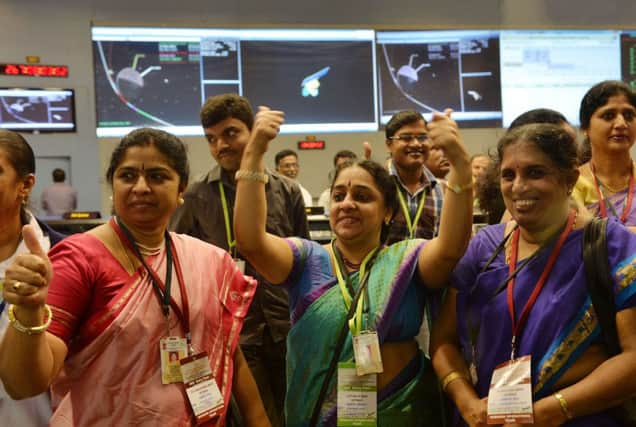Indian satellite goes into orbit around Mars


In scenes broadcast live on television, scientists cheered as the orbiter’s engines completed 24 minutes of burn time to manoeuvre the spacecraft into place around the red planet.
India is only the fourth nation or bloc of nations to send a craft into orbit around Mars.
Advertisement
Hide AdAdvertisement
Hide AdThe total cost of India’s mission was 4.5 billion rupees (£45 million) – in contrast to Nasa’s Maven mission to Mars which cost £409m.
It is likely to be the cheapest of the interplanetary space missions.
“We have gone beyond the boundaries of human enterprise and innovation,” prime minister Narendra Modi said at the Indian Space Research Organisation’s command centre in Bangalore. “We have navigated our craft through a route known to very few,” he added, congratulating the scientists and “all my fellow Indians on this historic occasion”.
Scientists described the final stages of the Mars Orbiter Mission, affectionately nicknamed Mom, as flawless.
The success marks a milestone for the space programme in demonstrating it can conduct complex missions and act as a global launchpad for commercial, navigational and research satellites.
Reaching the fourth planet from the Sun is a major feat for the developing country of 1.2 billion people.
India has a robust scientific and technical educational system that has produced millions of software programmers, engineers and doctors, as well as having large sections of the population living in poverty.
India describes Mom as the first successful Mars mission on a maiden attempt by any country, although the European Space Agency, a consortium of several nations, also reached Mars on its first mission in 2003.
Advertisement
Hide AdAdvertisement
Hide AdRival China is also expanding its space exploration programme with a space lab in orbit before a future permanent space station is established. It landed a rover on the Moon late last year.
Astronomy students who gathered at the Nehru Planetarium in New Delhi for Mars-themed learning activities and games were elated by the mission’s success.
“I am proud to be born in a country that can do anything and succeed,” said Kashish, 12.
Another 12-year-old, Mansha Khanna, said she was so inspired she wanted to become “a scientist or an astronaut, and do research about other planets”.
More than half the world’s previous attempts at getting a spaceship into orbit around Mars – 23 out of 41 – have failed.
India wanted this spacecraft – also called Mangalyaan, or Mars craft in Hindi – to be a global advertisement for its ability to design, plan and manage a difficult, deep-space mission.
India has already conducted dozens of successful satellite launches, including sending up the Chandrayaan-1 lunar orbiter, which discovered key evidence of water on the Moon in 2008. It is planning new scientific missions, including putting a rover on the lunar surface.
But India “is likely to be somewhat limited because we can’t afford to spend that much money on pure science exploration,” said a spokesman for the Delhi Science Forum.
Advertisement
Hide AdAdvertisement
Hide AdIndia’s focus will remain on developing technologies for commercial and navigational satellite applications, which could bring in significant revenues from companies or governments seeking to place their own satellites or research equipment in space.
MARTIAN CHRONICLES
Nasa, which has conducted 15 successful missions to Mars, including a spacecraft that arrived in orbit on Sunday, congratulated India in a Twitter message welcoming Mom to studying the red planet.
India’s 1,350kg (nearly 3,000lb) orbiter will now circle the planet for at least six months, with solar-powered instruments gathering scientific data that may shed light on Martian weather systems as well as what happened to the water that is believed to have existed once on Mars.
It also will search Mars for methane, a key chemical in life processes on Earth that could also come from geological processes.
The US has two more satellites circling the planet at the moment, as well as two rovers on the surface.